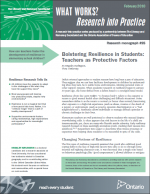When students feel supported and cared for in their school environments, they are less likely to abuse substances, to become involved in violence, and to participate in other problematic behaviors. These students are also more likely to develop positive attitudes toward themselves and prosocial attitudes and behaviors toward others. When schools promote students' sense of connectedness, belonging, and community, they facilitate positive outcomes.
High expectations for students – and necessary supports for students to reach those expectations – lead to high achievement. Setting these expectations during early elementary school can chart the course for students' future academic path. Expectations of success contribute to positive academic outcomes, as well as students' self-efficacy, self-awareness, and goals. Teachers who set high expectations, track students' progress in reaching those expectations, provide ongoing monitoring and support, and adjust goals as needed, help students succeed. Additionally, community building efforts in schools can reinforce academic achievement.
Students do better when they have opportunities to participate in and contribute to their own learning. Independence in making important academic choices allows children to feel ownership in their learning. This sense of control helps them develop self-motivation and resilience in academic tasks.
Battistich, V., & Hom, A. (1997). The relationship between students' sense of their school as a community and their involvement in problem behaviors. American Journal of Public Health, 87(12), 1997–2001.
Baumeister, R., & Leary, M. (1995). The need to belong: Desire for interpersonal attachments as a fundamental human motivation. Psychological Bulletin, 117(3), 497–529.
Hawkins, J. D., Catalano, R. F., Kosterman, R., Abbott, R., & Hill, K. G. (1999). Preventing adolescent health-risk behaviors by strengthening protection during childhood. Archives of Pediatric and Adolescent Medicine, 153, 226–234.
Heatly, M. C., & Votruba-Drzal, E. (2019). Developmental precursors of engagement and motivation in fifth grade: Linkages with parent- and teacher-child relationships. Journal of Applied Developmental Psychology, 60, 144–156. https://doi.org/10.1016/j.appdev.2018.09.003
Kincade, L., Cook, C., & Goerdt, A. (2020). Meta-Analysis and Common Practice Elements of Universal Approaches to Improving Student-Teacher Relationships. Review of Educational Research, 90(5), 710–748. https://doi.org/10.3102/0034654320946836
McCombs, B. (2012). Developing Responsible and Autonomous Learners: A Key to Motivating Students. American Psychological Association. Retrieved from: http://www.apa.org/education/k12/learners.aspx?item=1.
Schaps, E. (2005). The role of supportive school environments in promoting academic success. In: Getting Results: Update 5, Student Health, Supportive Schools, and Academic Success. Sacramento, CA: CDE Press.

